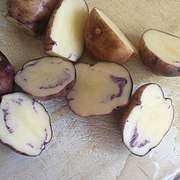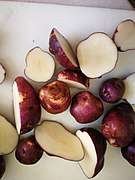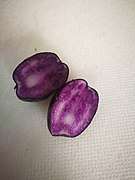Māori potatoes
Māori potatoes or taewa are varieties of potato (Solanum tuberosum subsp. tuberosum and andigena)[1] cultivated by Māori people, especially those grown before New Zealand was colonised by the British.[2]
Māori have grown potatoes for at least 200 years, and "taewa"[3] refers collectively to some traditional varieties, including Karuparerā, Huakaroro, Raupī, Moemoe, and Tūtae-kurī.[2][4] These are smaller, knobblier, and more colourful than modern potato varieties, which are referred to by the loanword pārete.[5] Other collective names for traditional Māori potatoes are rīwai, parareka and mahetau.[6]
Māori potatoes are commonly used as a base ingredient in rewena bread.[1]
 Whataroa potato (taewa), an example of a Māori potato
Whataroa potato (taewa), an example of a Māori potato Waipororo potato (taewa), an example of a Māori potato
Waipororo potato (taewa), an example of a Māori potato Urenika taewa (also known as Tūtae-kurī), an example of a Māori potato
Urenika taewa (also known as Tūtae-kurī), an example of a Māori potato
Origins and history
Potatoes originate in the Andes and temperate Chile, and were brought to Europe in the 15th century.[7]
Māori traditions maintain that taewa were cultivated well before Europeans first visited Aotearoa.,[1][2]. Despite this, James Cook is presumed by academic scholars to have introduced potatoes to New Zealand in his first voyage (1769), as is Marion de Fresne.[4] More South American varieties came with sealers and whalers in the early 19th century.[6]
Taewa became a staple Māori food crop before organised European settlement, displacing sweet potatoes (kūmara) and bracken fern root (aruhe) as a primary carbohydrate source.[1] Taewa were able to grow in cooler climates, and were easier to store than kūmara.[8]
They were also an important trade good during the first period of European contact with Aotearoa around 1800 onwards.[2] Māori grew taewa commercially until the late 19th century but these were gradually supplanted by larger commercial potato varieties from Europe, which have higher yields. Māori have continued to grow traditional varieties, passing them from generation to generation.[9] This selection over time has made them hardy and mostly disease resistant.[8]
Cultivation
Taewa are generally grown with the same techniques and technology as commercial varieties. Taewa tend to produce more tubers per plant, but they are smaller than modern potatoes.[8] Traditionally, they are planted in spring, with maintenance tasks during the summer, and harvest in late autumn. Crops were planted according to the maramataka using crop rotation methods, and wood ash for fertiliser. All levels of society took part in production and harvesting.[8]
Naming
Some taewa are known by multiple names. Koanga Institute have identified several that are infact the same variety of potato such as karoro and peru ma. [10]
Varieties of Taewa
- Amuri (aka Richard Watson)[10]
- Catriona[10]
- Chatham Hollomby[10]
- Chatham Island[10]
- Huakaroro / Karoro / Peru Ma[10]
- Kereopa / Ngateuteu[10]
- Kowiniwini[10]
- Maori Chief[10]
- Maori / Roke Roke / Waikato[10]
- Matariki[10]
- Moemoe[10]
- Paraketia[10]
- Pawhero[10]
- Stewart Island[10]
- Taranaki[10]
- Urenika[10]
- Wai-iti / Whanaako Ngati Porou[10]
- Waitai[10]
- Whataroa[10]
- Whero Whero[10]
Pests and disease
Prior to widespread European settlement, taewa did not suffer much from pests or disease. The biggest pest were native caterpillars which were controlled through fumigation using kauri gum or dried kawakawa leaves (Piper excelsum).[8]
Common pests
Today, insect pests include potato tuber moth (Phthorimaea operculella) and wireworm (Conoderus exsul) which both feed on leaves, stems, and may directly damage tubers.[8]
Aphids in particular are considered vectors for diseases. Taewa can be affected by green peach aphid (Myzus persicae), foxglove aphid (Aulacorthum solani), and potato aphid (Macrosiphum euphorbiae).[8]
Green looper caterpillar (Chrysodeixis eriosoma) and hadda beetle (Henosepilachna vigintioctopunctata) can also affect taewa, but generally only cause damage to the plant's foliage.[8]
Tomato and potato psyllid (Bactericera cokerelli) arrived in New Zealand in 2006[11] and poses a threat to many solanaceous crops, including taewa. Psyllids can reduce crop yields by up to 80%.[8]
Rats (Rattus rattus and Rattus norvegicus) and wild pigs (Sus scrofa) are known to attack tubers, while pukeko (Porphyrio porphryio melanotus), rabbits (Oryctolagus cuniculus) and hares (Lepus europaeus) may attack new foliage.[8]
Common diseases
Taewa are susceptible to potato leafroll virus, potato virus y, potato virus x, and potato virus s. These are spread by aphids, machinery, and the propagation of infected tubers.[8]
As well as viruses, taewa can be infected by a range of fungal diseases. Late blight (Phytophthroa infestans), pink rot (Phytopthora erythroseptica), Verticillium wilt (Verticillium albo-atrum and V. dahliae), and Fusarium dry rot (Fusarium sambucinum) have the biggest potential impacts on crops.[8]
Early blight (Alternaria solani), stem canker (Rhizoctonia solani), powdery scab (Spongospora subterranea), and silver scurf (Helminthosporium solani) will damage plants to a lesser degree.[8]
It has been noted that the varieties huakaroro, karupārera, and tūtaekurī show a small natural resistance to late blight. Powdery scab is more likely to affect huakaroro and urenika, while karupārera and moemoe appear highly resistant. The variety pawhero is particularly susceptible to Fusarium dry rot, which affects its ability to be stored.[8]
Common scab (Streptomyces scabies) may cause cosmetic damage to tubers. Bacterial soft rot (Erwinia carotovora) and Liberibacter and Zebra chip (Candidatus liberibacter solanacearum) may cause significant crop loss.[8]
References
- Roskruge, Nick (2014). Rauwaru, The Proverbial Garden, Ngā-Weri, Māori Root Vegetables Their History and Tips on their Use. Palmerston North, New Zealand: Institute of Agriculture and Environment, Massey University. pp. 29–31. ISBN 978-0-473-28219-6.
- "Māori potatoes". Museum of New Zealand Te Papa Tongarewa. Retrieved 30 January 2018.
- "Taewa". Te Aka Māori-English, English-Māori Dictionary.
- Nathan, Simon (24 September 2007). "Taewa (Māori potatoes)". Te Ara – the Encyclopedia of New Zealand. Retrieved 30 January 2019.
- "Pārete". Te Aka Māori-English, English-Māori Dictionary. Retrieved 31 January 2019.
- Harris, Graham; Niha, Poai Pakeha (1999). Ngā Riwai Māori – Māori Potatoes. Lower Hutt: The Open Polytechnic of New Zealand, Working Paper. hdl:11072/1195. ISBN 0909009236.
- "Taewa researcher tracks crops to United States". Massey University of New Zealand. Retrieved 30 January 2019.
- 1959-, Roskruge, Nick (2010). Ngā pōrearea me ngā matemate o ngā māra taewa = Pests and diseases of taewa (Māori potato) crops. Puketapu, Aleise., McFarlane, Turi R., Massey University. Institute of Natural Resources. Palmerston North, N.Z.: Institute of Natural Resources. ISBN 9780473176136. OCLC 671920229.CS1 maint: numeric names: authors list (link)
- "Taewa". Science Learning Hub.
- "Potato Trial Results 2013 – 2014". Koanga Institute. Retrieved 1 March 2020.
- "Factsheet: Tomato potato psyllid - Bactericera cockerelli". nzacfactsheets.landcareresearch.co.nz. Retrieved 1 February 2019.